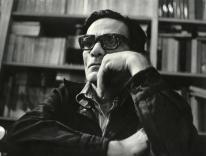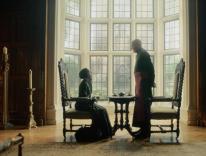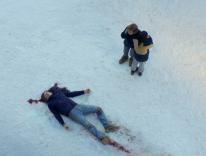All my seven Narnian books... began with seeing pictures in my head. At first they were not a story, just pictures. The Lion all began with a picture of a Faun carrying an umbrella and parcels in a snowy wood.
At first I had very little idea how the story would go, but then suddenly Aslan came bounding into it...once He was there He pulled the whole story together.
C. S. Lewis
“It All Began with a Picture”
Even if Andrew Adamson’s adaptation of The Lion, the Witch, and the Wardrobe were to possess no other merits, it does get the pictures right. Thanks to cinematographer Donald McAlpine, production designer Roger Ford, and a team of CGI wizards employed by Weta Workshop, that snowy wood conveys what Lewis called Northernness; the faun named Mr. Tumnus, his umbrella, and the nearby Edwardian streetlamp, are all wonderfully incongruous, piquant, and-as in the book-strangely comforting. These pictures, and the many other images that carry the story forward, materialize an imagination that longs for the mythic but savors coziness even more. About a dozen minutes into the film, we know we are safe in Narnia.
Adamson accepts Lewis’s hodgepodge of legend and lore: centaurs and minotaurs, Father Christmas, a snow queen out of Hans Christian Andersen who is served by dwarfs out of Wagner’s Rhinegold and opposed by talking animals out of The Wind and the Willows. It’s easy to understand why a purist like J. R. R. Tolkien hated his friend’s fictional gallimaufry, yet there is nothing ersatz about the emotions the Narnia books arouse. The stories are rooted in loss, Lewis’s loss of his mother to death, reconfigured as the Pevensie children’s loss of their blitzed London home, and their separation from the parents forced to send the siblings out to the countryside and into the large, rambling house of a nameless professor. Adamson has made much more of the evacuation premise than Lewis did, and he evokes each child’s idiosyncratic response to the upheaval: Peter enacting the role of responsible authority, Susan questioning Peter’s sternness, Edmund’s sulky rebellion against decisions made for him, Lucy’s quiet acceptance of her new circumstances. Some may object to all this groundwork as needlessly psychological, but I found it compelling. Surely the better we know these children in their earthly existence, the more significant will be the character changes brought about by the adventures and the questing and testing undergone in Narnia. Shunted about by adults in a world scarred by Hitler, the Pevensies become masterful lords and ladies in a realm confected out of Lewis’s variegated reading and unified by the Christianity embodied by Aslan the Lion, a godlike figure who can be both killed and resurrected.
Anchored in historical turbulence, the movie can then launch into fantasy without losing its very human pith. Mr. Tumnus (charming performance by James McAvoy) may be a faun but he is also a tidy householder who knows how to serve up a delicious tea to his first human guest, Lucy. Before he leads her into his cottage, he stomps the snow off his feet; of course those feet are hooves, and their crisply recorded tap-tap-tap is simultaneously so domestic and yet so wild-this oxymoronic feeling pervades Narnia-that the children at the screening I attended exclaimed with delight and imitated the tapping by clucking their tongues against the roofs of their mouths. Charming, but Tumnus then gives a furtive glance to discover if any spy has seen him with this proscribed human. This clues us in to the fact that though Narnia may look like a winter wonderland it is also a police state where “it’s always winter but never Christmas.” The Lion is a fantasy but the sense of evil informing it gives the fantasy weight.
The visual presentation of the animals has the same combination of reality and whimsy. Seen from a distance the wolves (the witch’s Gestapo) look like real wolves but up close their faces are the visages of secret police hooligans, while the beavers who befriend the Pevensies look like actual beavers in their initial long shots and then take on the joviality and pluckiness of proverbial Cockneys in their close-ups.
As the narrative presses forward into alarums, excursions, rescues, and battles, Adamson’s movie seems to have Peter Jackson’s The Lord of the Rings looking over its shoulder, what with the camera panning over New Zealand landscapes (Polish and Czech locales were also used), and all the pitched battles featuring knights bashing and lancing mythic monsters. Admittedly, this first installment of The Chronicles of Narnia would not have come into existence had not Jackson’s epic cleaned up at the box office and at the Academy Awards, but that doesn’t make The Lion a mere epigone of The Lord. If the Narnia movie seems less sweeping, it is also less sprawling. If its battles and expeditions are less grand, they are also more immediately gratifying. And the (relative) modesty of scale in the new movie is justified by the fact that the Narnia books are tales, allegorical to a degree, but nevertheless yarns, shapely and concise narratives, and not at all the prose epic that Tolkien achieved.
Precisely because The Lion functions as a self-contained story as well as book 1 of a series, its characters come more quickly into focus than those of The Lord. And how shrewdly Adamson has cast each of the roles that needs a human actor. William Moseley as Peter is a plucky British schoolboy with an inner knight. Anna Popplewell, a proto-Charlotte Rampling, may make Susan a mite too much of a nag at first but she grows more engaging in the concluding scenes. Skandar Keynes explores Edmund’s dark side without ever making him an obnoxious brat. You want this traitor to be redeemed. I don’t know if Georgie Henley will grow into a great actress; what’s important is that she comes across as a saintly gnome who deserves to administer the healing balm Aslan entrusts to her. Lucy is the compassionate heart of the series, and Ms. Henley wins the hearts of the audience.
The great performance, however, is Tilda Swinton’s as Queen Jadis the White Witch. The 1988 BBC version of the Narnia series still does yeoman service, but its White Witch is dreadful-a third-rate Margaret Hamilton who makes faces and screeches. Swinton knows that evil doesn’t scream and repel, it purrs and seduces. Her Jadis can cosset Edmund at one moment, then smack him to the ground with a good backhand. This queen is beautiful and vacant. She has stared into nothingness and believes in nothingness and, finally, is nothingness. Awaiting her impending death at the jaws of Aslan, Jadis shows neither fear nor defiance. She has been expecting this moment for a long time. Death is her proper kingdom, not Narnia. So the witch is splendid and the wardrobe is a gorgeous mahogany affair, but what of the Lion?
The most memorable remark about Aslan in the book is that “he isn’t a tame lion.” Yet, at the moment of the cinematic lion’s resurrection, Aslan seems tame indeed, merely bounding back into view and showing off his refurbished mane. But Lewis, intending his resurrection scene to be more bacchic than its gospel counterpart, has Aslan dancing and romping with Susan and Lucy, then flying to the rescue of the creatures the witch had turned to stone. Adamson skims the entire sequence so that it hardly feels like the climax it is.
Yet if the director had staged these moments with vigor, would Aslan even then register as a great screen character? On the page, the lion’s power is felt through the way the children perceive him. But on screen (and this is true of the BBC series, too) Aslan is just a big, well-digitized stuffed animal, a little more impressive than a centaur, a little less than the Minotaur. His voice is Liam Neeson’s, the eyes show compassion, and the mane is impressive, but none of this adds up to Aslan, the Narnian counterpart of Christ.
I am melancholy whenever an adaptation of one of my favorite books becomes a great movie. A film’s memorable, concrete imagery replaces the reader’s mental pictures, and one sighs to see them go. Alastair Sim has long lodged in my head as Scrooge, and Emma Thompson made any other imagining of Miss Dashwood in Sense and Sensibility impossible. This is a mixed blessing. Thank God, then, that The Lion, the Witch, and the Wardrobe is only excellent and not a masterpiece. Although now Tilda Swinton rules forever as Jadis, Aslan remains safe in a wardrobe within some obscure lobe of my brain.
Please email comments to [email protected] and join the conversation on our Facebook page.
Share
Previous Story
A Nearness in Difference
Next Story
Saving the Forsaken


